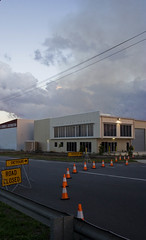'Technology and the Law: Can the law keep pace with nanotechnology?'The Hon Justice Michael Kirby AC CMGDelivered at QUT, 18 June 2007, 12.30-1.30pm
The Hon Justice Michael Kirby attended the QUT/Trilby Misso Public Lecture Series to report on his paper delivered at TELOS: Regulating Technologies Inaugural Conference in London on 8 April 2007, which formally launched the Centre for Technology, Ethics and Law in Society, based in the School of Law at King's College London. The conference was opened by Professor Lawrence Lessig (Stanford), and was followed by sessions on:
• Regulating Today's Technologies (ICT and biotechnology)
• Regulating Tomorrow's Technologies (neurotechnology, nanotechnology, AI and technological convergence)
• Technology as a Regulatory Tool
In attempting to achieve an interdisciplinary and informative mix of lawyers and scientists, speakers included Richard Ashcroft, Deryck Beyleveld, Ben Bowling, Roger Brownsword, Andrea Buechler, Bert Gordijn, Serge Gutwirth, Paul de Hert, Mireille Hildebrandt, Andrew Jones, Judy Illes, Bert-Jaap Koops, Graeme Laurie, T.J. McIntyre, Andrew Murray, Stephen Minger, Charles Raab, Han Somsen, Mingyuan Wang, Karen Yeung, and Jonathan Zittrain.
Kirby J had the difficult honour of summarising the proceedings. The most significant formulation of the status of technology has come from Professor Lawrence Lessig, who writes in
Code, that control is now architected in systems and technology. When multinationals dictate terms in such a fashion, whither democracy? It is therefore important to reassert the social values via legal reforms in respect to technological change. This is, of course, difficult given the average lawyer's understanding of science. (As a generalisation, lawyers tend to be bookish individuals, good with words, and not so attracted to mathematics and the sciences.)
When Kirby J headed the ALRC in Australia, he was called upon to consider biotechnology and informatics. Whilst at King's, he was given particular insight by a Belgian professor who considered the historical precedent of human knowledge with monks and reading. With the printing press, words had acquired a life of their own, compared to when transcribed by monks, where they were reified and not spoken. The pace of understanding can now be four to five times greater than in the pre-printing press days, owing to the dissemination of words.
When Kirby J headed the ALRC, Bob Ellicott, Australia's Attorney General, mandated that the commission consider human tissue transplants (and not some arcane Australian income tax law issue, unfortunately!) This was to be conducted in the context of increasing technological, medical, and pharmacological developments and capacities. The commission contemplated the acceptance of organ donation in society. (Has this changed?) They were briefed to consider the definition of 'death', and to examine the appropriateness of allowing children and prisoners to donate organs (where there may be duress), and whether relatives have the capacity to veto an individual's donation decision post-mortem. The ALRC report met considerable success: it was originally commissioned for the ACT ordinance, but steadily received uniform adoption and translation. Interestingly, in the final stages of the drafting of the report, the first IVF child, Louise Brown, was born. Should IVF be considered another tissue? Was it different in kind? What was the status of the husband in this area? The commission wisely excluded IVF from its terms of reference, as the issue would only delay the release of the findings and make them overly complex. IVF was considered separately.
What privacy protection could parties expect (in approaching 1984)? The OECD countries (including the Nordic countries and the European Community) formulated a transcontinental privacy policy in 1978, which was translated ten years later into the Australian Privacy Act (Cth) 1988, with its Privacy Principles in Schedule 3. There has, however, been a difficulty with the use specification principle, which states that the user's information shall remain private unless the user consents to its use or that legal authority requires it. When one contemplates the workings of Google and Yahoo! this is clearly problematic and one may 'laugh at it'. It has therefore been necessary to rethink these basic principles.
Society must be constantly vigilant regarding the problems and solutions posed by new technologies. It appears that technological development is interrelated – there would be no nanotechnology without the push towards miniaturisation required by the space race (and its preoccupation with weaponry). Computerisation is facilitated through these microchip advances. With computers, one is able to crunch the huge amounts of data required by biotechnology, in coding the human genome. It is clear that, in order to preserve democracy, we must respond to rapid technological change.
In summarising the London session at King's, Kirby J found that there were five paradoxes and seven lessons to be noted. The paradoxes are, in part, as follows:
1. There are no experts in these fields, because the technology is too new, complex, and unknown. There are naturally nano-optimists and nano-pessimists, yet the technology is still arriving and we are yet to grasp it fully. An interesting example came with the Sony TPM case and the almost Papal divisions of the world into regions. The USFTA was insistent on patching the Australian legal decision where it came to mod chips. Copyright must not go beyond its bounds and infringe upon free expression, as proclaimed by Lawrence Lessig.
2. There is either too much or too little law. Lawmakers occasionally pre-empt developments, as with artificial insemination and human cloning. However, not to act is equally to decide the issue. As with the hybridisation of HIV and issues of xenotransplantation, we should regulate these areas. Not to act is often irresponsible and sets a particular course.
3. We should look not to economic but rather social advantage. We should be aware of the architecting of behaviours from multinational corporations encoding laws into the technology itself (as per Lessig in
Code).
4. Are these issues of interest to the lay person? We should make sure that the populace is engaged in the debate.
5. [This point seems to have merged with the previous!]
The lessons of this debate, where technology is global, and yet laws are local, and where not to act is to make a decision, are as follows:
1. Individual nation states have limited powers to regulate technology. Witness the case over the French attempt to prevent NAZI memorabilia from being on the Internet. There is, however, certain US supremacy.
2. There is a gradation of urgencies. A top priority must be the regulation of the nuclear industry. We must engage with thorough risk assessment, and observe the interrelations of ICTs with nuclear power and biotechnology, for example. All developments are related.
3. There will be different negotiations amongst different cultures. Where do we stand in relation to morality and religion, between secular society and fundamentalist states?
4. We need to base the law on good knowledge and sound science, not intuition and assumptions (as with Osborne on AIDS).
5. There is a democratic deficit in the exceptions allowed by technology. Compare the London tube ticket barriers with those of Le Metro in Paris – where a metal gate prevents you jumping over barriers. There are no exceptions allowed, no permeability of the borders. Lessig notes the importance of fair use exceptions to a functioning democracy. Consider when technology allows for no exceptions, where it excludes and allows for no difference – there is no discretion, no negotiation. Behaviours are regulated in code, are architected into technologies, and not through the representative, democratic process. It is important to keep the law in tune with the social order and expectations.
6.& 7. Again, seem to have merged with the previous!
QuestionsOf international law, bioethics and human rights: medical ethics tend to be instituted by doctors, whereas post-war developments in human rights have been designed by lawyers. We must perceive our place in the biosphere and look to other species' concerns as our own. We must have experts talk to each other, to engage in interdisciplinary dialogue.
Equally, international dialogue is critical. These issues are not to be solved on a state-by-state basis. International conventions and treaties play a large role here – even when they aren't enacted in specific countries and are therefore not binding, they stimulate local debate and revisions of local laws. Take, for example, the success of the International Disability Convention.
What of lay appreciation of complex technological issues? We must plot the technological trajectories and engage in response. To omit to do so is to act, to set the course.
Consider the humanoid, as spoken about at King's. If the Library of Congress's knowledge can fit into a single microchip, it is feasible that all the knowledge contained within a human can fit into a humanoid. This cyborg may be sent into outer space to continue human knowledge and the mind, to preserve our ideas in perpetuity. What are the ethics of this act? We must engage with natural evolutionary developments.
What of science's involvement with the law? The ALRC had scientific advisors, and the panel at King's contained experts in technological matters. It is true that sectors have different spheres of interest: hence the importance of dialogue. Lionel Murphy CJ had science qualifications. He therefore brought different insights and a fresh perspective to issues.
It is the place of law to engage, to be responsive, to be relevant.
Kirby J will make available his report to King's.
Biography (c/- QUT):
Justice Michael Kirby is one of the seven Justices of the High Court of Australia, the nation's highest court. He was born and educated in Sydney and called to the New South Wales bar. In 1975 he was appointed a Deputy President of the Australian Conciliation and Arbitration Commission. In the same year he began a decade of service as the inaugural Chairman of the Australian Law Reform Commission. In 1983 he was appointed a judge of the Federal Court of Australia and in 1984 President of the New South Wales Court of Appeal. In 1995 he was appointed to the additional post of President of the Court of Appeal of Solomon Islands. His appointment to the High Court of Australia followed in 1996.
Justice Kirby has taken an active part in international bodies including the World Health Organisation, UNAIDS, UNDP, ILO, UNODC, UNESCO, OECD and the Commonwealth Secretariat. Between 1993-6 he was Special Representative of the Secretary-Generation for Human Rights in Cambodia. Between 1995-8 he was President of the International Commission of Jurists. In 2006 he was elected an Honorary Bencher of Inner Temple.



















